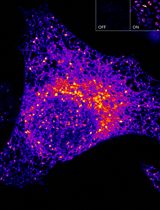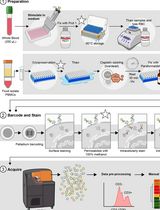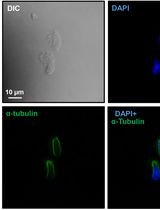- EN - English
- CN - 中文
Quantification of the Surface Expression of G Protein-coupled Receptors Using Intact Live-cell Radioligand Binding Assays
利用完整活细胞放射配体结合分析定量G蛋白偶联受体的表面表达
发布: 2020年09月20日第10卷第18期 DOI: 10.21769/BioProtoc.3761 浏览次数: 4878
评审: Qin WangSha LiAnonymous reviewer(s)

相关实验方案

高灵敏且可调控的 ATOM 荧光生物传感器:用于检测细胞中蛋白质靶点的亚细胞定位
Harsimranjit Sekhon [...] Stewart N. Loh
2025年03月20日 2160 阅读

用于比较人冷冻保存 PBMC 与全血中 JAK/STAT 信号通路的双磷酸化 CyTOF 流程
Ilyssa E. Ramos [...] James M. Cherry
2025年11月20日 2131 阅读
Abstract
G protein-coupled receptors (GPCRs) are the most structurally diverse family of signaling proteins and regulate a variety of cell function. For most GPCRs, the cell surface is their functional destination where they are able to respond a wide range of extracellular stimuli, leading to the activation of intracellular signal transduction cascades. Thus, the quantity of receptor expression at the cell surface is a crucial factor regulating the functionality of the receptors. Over the past decades, many methods have been developed to measure the cell surface expression of GPCRs. Here, we describe an intact live-cell radioligand binding assay to quantify the surface expression of GPCRs at the endogenous levels or after overexpression. In this assay, cell cultures will be incubated with specific cell-nonpermeable radioligands which selectively and stoichiometrically bind to individual GPCRs and the receptor numbers at the cell surface are quantified by the radioactivity of receptor-bound ligands. This method is highly specific for measuring the functional GPCRs at the surface of intact live cells and is particularly useful for endogenous, low-abundant GPCRs.
Keywords: G protein-coupled receptor (G蛋白结合受体)Background
G protein-coupled receptors (GPCRs) constitute the largest superfamily of cell surface receptors and modulate a variety of cell functions under physiological and pathological conditions (Hauser et al., 2017; Hilger et al., 2018; Weinberg and Puthenveedu, 2019). The precise functions of individual GPCRs at the cell surface are initiated by their binding to specific ligands which in turn activates cognate heterotrimeric G proteins or other signaling molecules, leading to the activation of intracellular signal transduction cascades. Although GPCR-mediated signaling and functioning are sophisticated processes which are coordinated by many factors, the net amount of receptor surface expression is undoubtedly a crucial element regulating the magnitude and duration (Zhang and Wu, 2019).
The quantity of GPCR expression at the cell surface is a balance of highly regulated, dynamic intracellular trafficking, including maturation, internalization, recycling, and degradation. Over the past decades, numerous methods have been well established to quantify the surface GPCRs, such as ELISA, flow cytometry, biotinylation, radioligand binding and imaging (Dunham et al., 2009; Qin et al., 2011; Zhu et al., 2015; Shiwarski et al., 2017 and 2019). Here, we describe an intact live-cell ligand binding assay to quantify their surface expression at steady state by using cell membrane-nonpermeable radioligands. In this assay, live cells will be incubated with individual receptor-specific antagonists or agonists labelled with radioactive isotopes at a saturating concentration. Since these radioligands are not able to penetrate the plasma membrane, the radioactivity of ligands bound to the cells will reflect the quantity of receptor expression at the cell surface. As the ligands used are radiolabeled and stoichiometrically bind to specific GPCRs, this method provides a very sensitive and highly specific approach to accurately quantify the surface functional GPCRs which are able to bind to their ligands in intact live cells and is particularly useful for endogenous, low-abundant GPCRs whose quantification by other methods is extremely difficult.
We have used this method to measure the surface expression of a number of family A GPCRs in different cell types at the endogenous levels or after overexpression (Filipeanu et al., 2004; Dong and Wu, 2006 and 2007; Dong et al., 2008; Duvernay et al., 2009a and 2009b; Dong et al., 2010a and 2010b; Duvernay et al., 2011; Zhang et al., 2011; Dong et al., 2012; Fan et al., 2012; Li et al., 2012; Zhang et al., 2016a and 2016b; Li et al., 2017; Wei et al., 2019; Zhang et al., 2019). Here, we first describe the procedures to measure the surface expression of α2B-adrenergic receptor (AR), which has long been used as a model GPCR in our studies, in NG108-15 neuroblastoma-glioma and MCF-7 breast cancer cells which express α2B-AR endogenously, and in human embryonic kidney 293 (HEK293) cells in which α2B-AR was overexpressed by transient transfection or inducible systems. We will then briefly discuss the quantification of surface expression of other GPCRs by using radioligand binding of intact live cells.
Materials and Reagents
- 6-well plates (Thermo Fisher Scientific, catalog number: 130184 )
- 12-well plates (Thermo Fisher Scientific, catalog number: 130185 )
- HEK293 cells (ATCC, catalog number: CRL-1573 )
- NG108-15 cells (ATCC, catalog number: HB-12317 )
- MCF-7 cells (ATCC, catalog number: HTB-22 )
- [6,7-3H(N)]-RX821002 (PerkinElmer, catalog number: NET1153250UC )
- [7-methoxy-3H]-Prazosin (PerkinElmer, catalog number: NET823025UC )
- [5,7-3H]-CGP12177 (PerkinElmer, catalog number: NET1061250UC )
- [125I]-Angiotensin II, [125I]-Ang II (PerkinElmer, catalog number: NEX105050UC )
- [N-methyl-3H]-Scopolamine methyl chloride, [3H]-NMS (PerkinElmer, catalog number: NET636250UC )
- Phentolamine hydrochloride (Sigma, catalog number: P7547 )
- Rauwolscine hydrochloride (Tocris, catalog number: 0 891 )
- Alprenolol hydrochloride (Sigma, catalog number: A8676 )
- Angiotensin II, Ang II (Calbiochem, catalog number: 05-23-0101 )
- Atropine (Sigma, catalog number: A0132 )
- Doxycycline hyclate (Sigma, catalog number: D9 891 )
- Dulbecco’s modified Eagle’s medium, DMEM (Sigma, catalog number: D6429-500ML )
- Fetal bovine serum, FBS (HyClone, catalog number: SH30396.03 )
- Penicillin-streptomycin solution (HyClone, catalog number: SH40003.01 )
- Hypoxanthine (Sigma, catalog number: H9377 )
- Aminopterin (Sigma, catalog number: A3411 )
- Thymidine (Sigma, catalog number: T9250 )
- Poly-L-lysine hydrobromide (Sigma, catalog number: P1274 )
- Trypsin-EDTA (0.25%) (Sigma, catalog number: T4049-100ML )
- Opti-MEM (Gibco, catalog number: 31985-070 )
- Lipofectamine 2000 (Invitrogen, catalog number: 11668-019 )
- 10× Phosphate buffered saline, 10× PBS (Sigma, catalog number: P5493-4L )
- NaOH (Sigma, catalog number: S5881-500G )
- Scintillation solution, ScintiVerseTM BD cocktail (Fisher Chemical, catalog number: SX18-4 )
- High density polyethylene vials, 20 ml capacity (RPI, catalog number: 121043 )
- Poly-L-lysine (see Recipes)
- NG108-15 growth medium (see Recipes)
- DMEM complete medium (see Recipes)
- 3H-RX821002 binding solution (see Recipes)
- 3H-RX821002 binding solution containing 10 µM rauwolscine (see Recipes)
Equipment
- Low speed orbital shaker (Southwest Science, catalog number: SBT30 )
- Hemocytometer (Hausser Scientific, catalog number: 1483 )
- Cell culture incubator (Thermo Scientific, Forma series II water jacketed CO2 incubator)
- Tissue culture microscope (Nikon, model: Eclipse TS100 )
- Scintillation counter (Hitachi, model: AccuFLEX LSC-8000c )
Software
- Microsoft Excel
Procedure
文章信息
版权信息
© 2020 The Authors; exclusive licensee Bio-protocol LLC.
如何引用
Xu, X. and Wu, G. (2020). Quantification of the Surface Expression of G Protein-coupled Receptors Using Intact Live-cell Radioligand Binding Assays. Bio-protocol 10(18): e3761. DOI: 10.21769/BioProtoc.3761.
分类
细胞生物学 > 细胞信号传导 > 胞内信号传导
分子生物学 > 蛋白质 > 检测
您对这篇实验方法有问题吗?
在此处发布您的问题,我们将邀请本文作者来回答。同时,我们会将您的问题发布到Bio-protocol Exchange,以便寻求社区成员的帮助。
Share
Bluesky
X
Copy link











